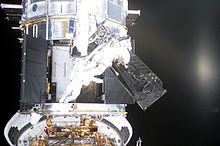STS-109
[3] Initially designed to operate for 15 years, plans for periodic service and refurbishment were incorporated into its mission from the start.
[4] After the successful completion of the second planned service mission (SM2) by the crew of STS-82 in February 1997, three of the telescope's six gyroscopes failed.
The STS-109 astronauts performed a total of five spacewalks in five consecutive days to service and upgrade the Hubble Space Telescope.
Columbia made its twenty-seventh and last successful landing at Kennedy Space Center, as on its next mission, STS-107, it disintegrated on re-entry, killing all aboard.
This article incorporates public domain material from websites or documents of the National Aeronautics and Space Administration.




